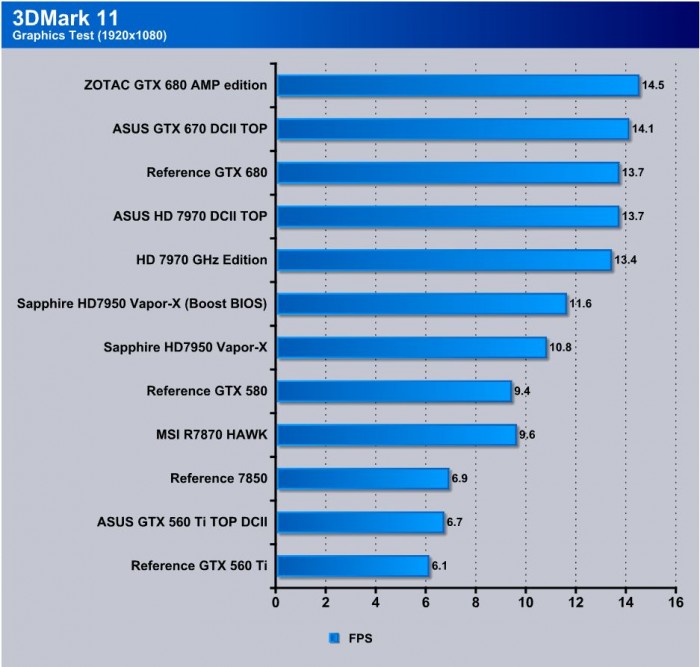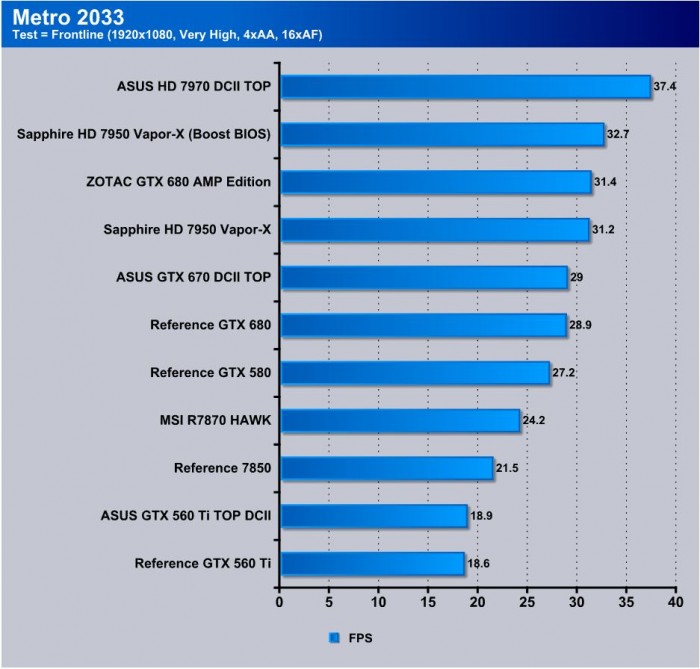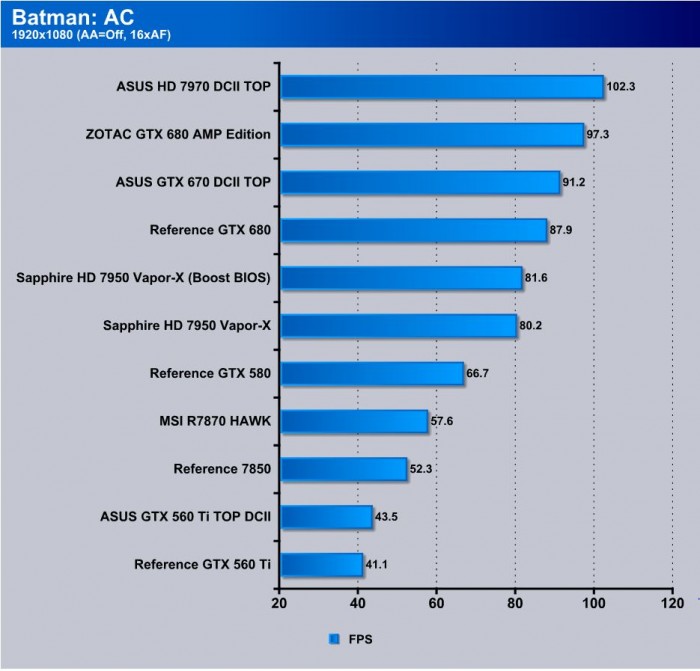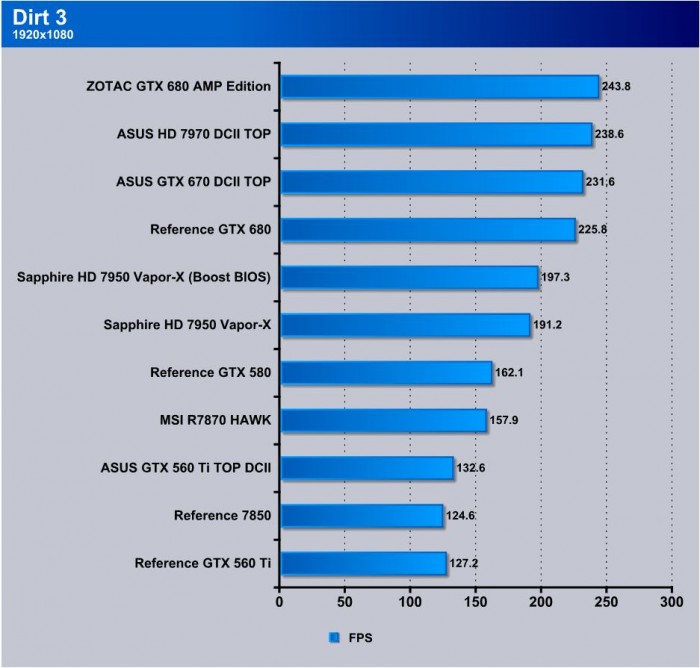ASUS HD 7970 DirectCU II TOP
Testing & Methodology
We’ve expanded our testing suite considerably since the X79 chipset release, and will continue to use the same methods for most of the motherboards and CPU’s we test. In the interests of thoroughness and accurate results, we run each test at least three times, and some tests more than that. We average the total of all the tests from each benchmark then report the average here.
The OS we use is Windows 7 Pro 64bit with all patches and updates applied. We also use the latest drivers available for the motherboard and any devices attached to the computer. We do not disable background tasks or tweak the OS or system in any way. We turn off drive indexing and daily defragging. We also turn off Prefetch and Superfetch. This is not an attempt to produce bigger benchmark numbers. Drive indexing and defragging can interfere with testing and produce confusing numbers. If a test were to be run while a drive was being indexed or defragged, and then the same test was later run when these processes were off, the two results would be contradictory and erroneous. As we cannot control when defragging and indexing occur precisely enough to guarantee that they won’t interfere with testing, we opt to disable the features entirely.
Prefetch tries to predict what users will load the next time they boot the machine by caching the relevant files and storing them for later use. We want to learn how the program runs without any of the files being cached, and we disable it so that each test run we do not have to clear Prefetch to get accurate numbers. Lastly we disable Superfetch. Superfetch loads often-used programs into the memory. It is one of the reasons that Windows occupies so much memory. Vista fills the memory in an attempt to predict what users will load. Having one test run with files cached, and another test run with the files un-cached would result in inaccurate numbers. Again, since we can’t control its timings so precisely, it we turn it off. Because these four features can potentially interfere with benchmarking, and and are out of our control, we disable them. We do not disable anything else.
We are revamping our testing method in order to better represent motherboard performance and offering to the consumer. Also we want to make it an easier read for you without miles of endless charts. We ask that you provide feedback in an effort to help us deliver better reviews for you.
Test Rig
| Test Rig | |
| Case | Thermaltake Level 10 GT |
| CPU | Intel Core i7-3770K/Intel Core i7-2600K |
| Motherboard | ASUS Maximus V Gene |
| Ram | 16GbpsB Patriot Viper Xtreme 2400MHz + |
| CPU Cooler | Swiftech H20-220 Edge |
| Hard Drive | Western Digital Velociraptor 300GB |
| SSD | Intel 510 series SATA III 120GB |
| Optical | ASUS BD-ROM |
| GPU | ASUS HD 7970 DirectCU II TOP |
| Additional Cards |
N/A |
| PSU | Thermaltake Toughpower XT 1275W Platinum |
| Mouse | Tt eSPORTS Black gaming mouse |
| Keyboard | Tt eSPORTS Meka G1 mechanical gaming keyboard |
Test Suite
We will use the following applications to test the performance of the graphics card.
Synthetic Benchmarks & Games
| Benchmarks |
|---|
| 3DMark11 |
| Alien Vs Predator |
| Batman: Arkham City |
| Dirt 3 |
| Metro 2033 |
Overclocking
The ASUS HD 7970 DirectCU II TOP edition card has a specially sorted GPU and super strong SAP components ready to push the limits. So now we just need to find where this limit is.
Starting up we first found the GPU limit on air was around 1260MHz, which is rather good. This should make for some amazing gaming increases for users looking to get that last little edge in their favorite games.
Memory overclocking was definitely nice as we saw some real gains here as well with stability capping out at around 1700 MHz so backing it to 1680 MHz provided us a so-called “safe zone”. Even then it was still a very high clock so we cannot say that it would not cause some sort of degradation over the life of the card.
| Clock | Stock Frequency | Max stable MHz |
OC Percent |
| GPU Base clock | 1000MHz | 1260MHz | 26%+ |
| Memory clock | 1400MHz (5600MHz) | 1680MHz (6720MHz) | 20%+ |
In order to ensure no system bottleneck we clocked the CPU to 4.6GHz to ensure there is no reason the system will slow down the cards performance at all.
Some may ask why we chose the mainstream Z77 system, and we can explain. Up until recent the X79 enthusiasts platform did not really support PCI-E Gen 3 on the Nvidia 600 series GPU’s. Because of the inherent instability many have seen with the X79 platform with Gen 3 products, Nvidia has been hesitant to enable it, and now there is a workaround via registry to get it working. However, in order to ensure the most consistent testing possible, we have stuck to the natively supported Z77 platform.
Important note: Overclocking can cause component failure. Please exercise caution when attempting any level of overclock on system components.
Temperatures
The temperatures were recorded with full loaded Heaven benchmark looping for over 30 minutes or longer depending how long it took for the card to level out in temps and sat at a plateau for more than 10 minutes.
| GPU Temperatures | Temperature (Idle/Load) |
| ASUS HD 7970 DirectCU II TOP OC | 32C/71C |
| ASUS HD 7970 DirectCU II TOP | 32C/67C |
The DirectCU II cooler stayed quiet at idle with no discernible noise from it what so ever and even under heavy load you could only slightly notice it on an open test bench. This should mean that in a chassis for a gaming system its not likely you would hear this card during normal gaming sessions.
Real world/Gaming Benchmarks
3DMARK 11
3DMark 11 is the newest in Futuremark’s suite of benchmarking utilities. Its a fully capable DirectX11 benchmark which also stresses and analyzes the system performance as a whole to simulate a heavy rendering environment such as a high end game or other app the end user may run. This benchmark was run with Performance settings 5 times and all runs were averaged for the result below.
3DMark 11 shows a nice picture of where each card falls in line coming from our testbench. The HD 7970 DCII TOP is coming in right on the heels of the GTX 680 which is not a bad spot to be by any means. With some overclocking action it could top the 680 by a few marks as well.
Alien Vs. Predator
Alien vs Predator looks like a very AMD friendly game as we see that the HD 7970 DCII tops the charts by a decent margin easily sweeping away the 680.
Metro 2033
Metro 2033 has always been extraordinarily stressful for GPU’s, and this has not changed with time. Once again Metro is definitely a little friendlier with AMD cards as the DCII tops the charts from the HD 7970 camp and even the 7950 beating the 680.
Batman: Arkham City
We tested Batman Arkham City and once again the HD 7970 DirectCU II took a top spot but this time by a much smaller margin over the 680 which is a testament to the raw power of this card.
Dirt 3
Dirt 3 is heavily marketed by AMD, so we were surprised that the 680 came out slightly on top of the 7970 model. Still, this is a very strong showing for the DirectCU II model card.
 Bjorn3D.com Bjorn3d.com – Satisfying Your Daily Tech Cravings Since 1996
Bjorn3D.com Bjorn3d.com – Satisfying Your Daily Tech Cravings Since 1996




















The price is moot. As well as this card is engineered the size & prices makes this product irrelevant imo.
Hi Wayne,
Why do you say the size and price make the card irrelevant? ASUS makes multiple HD 7970 models to fit multiple needs and price points but the sheer size has more to do with improving performance capability. This is something seen regularly in the high end market from many manufacturers.
If you would like to elaborate on this or possibly in our user forums I would really like to get more insight on your perspective and discuss this.
Have a great holiday!